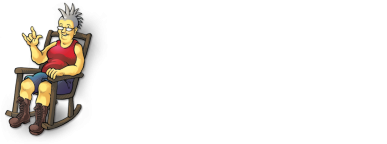Not many children’s book authors can count members of The Throwing Muses, The Butthole Surfers and Dee Dee Ramone among those who have publicly endorsed their work, but the husband and wife creative team of John Seven and Jana Christy Seven are that rare pair. First having sharpened their collective pens in the alternative comics world, bringing to life the rat packed tales of hepcat Very Vicky; over the past decade and a half the couple have published a number of storybooks and a travel guide intended for the often saccharine world of children and families that pleasingly maintain both an outsider and thought-provoking edge.
In their latest sweetly illustrated book, A Rule Is To Break: A Child’s Guide To Anarchy (Manic D Press) the Sevens encourage kids, and their parents, to embrace anarchy as part of their family’s values. Not exactly “The Giving Tree” if you know what we mean. Since a book like this seemed pretty much right up the alley of all of our readers, we got in touch with the authors at their home in western ma to hear more.
This just in – The Guardian reports the Tea Party have officially condemned this book.
Read the article here: “Tea Party condemns children’s book on anarchy”
______________
Rocker: How did you come up with the idea of having a children’s book based on Anarchy?
John: Our own frustration, really. It was conceived in the early months of 2011 and was a direct reaction to things that were going on both in the world and in our personal and professional spheres. Jana had done drawings of Wild Child for her own amusement and then threw the title out there. We got a good laugh about it, but then I started to write a story around the character and the title, mixing around the colloquial meaning of the word “anarchy” with some of the political and philosophical ones. We self-published it in the summer of that year, and were really amazed when Occupy exploded in the fall. It was like a mass demonstration of the ideas we were expressing in our children’s book, which was great. It energized us.
Jana: Also, we’re just really tired of the “learn a valuable lesson” formula in children’s books.
Rocker: Were there anarchistic ideas that you originally came up with that got put by the wayside?
John: Not really, because the original, self-published version of the book was a little more bombastic than this one, so we got a lot of it out of our system. It had “painting pictures on your TV,” for instance, which we know kids really loved, and parents were really unsure of. At the end of that version, Wild Child also ripped up the book, which played really well to a certain audience and really cracked kids up. This new expanded new version is an attempt to present the ideas in a more universal, make the concept of anarchy more palatable to people who might not respond to an in-your-face representation.
Rocker: There are some ideas in the book I can see being semi-controversial, like encouraging kids to things like “No more baths ever” and “Stay up all night.” I know you are parents yourself so what would you say to parents who are concerned a book like this could steer their kids in “the wrong direction”?
Jana: Let me just say, that I hate child-rearing manuals – this book is not that. We’re obviously playing with boundaries that kids and parents might face, asking them to question them, and then decide for themselves what to do in any given situation.
We started questioning child-raising authority when our kids were 3 days old and already begging us to break the rules (“Please feed us. I know the books says to wait 3 hours, but seriously. We’re tiny and hungry!”), and continued to actively question rules and let our kids break rules throughout their childhood and adolescence. We have brains, authority and responsibility, so, our kids didn’t endanger themselves; they learned how to be polite, respectful human beings who are very aware of the larger community that they are a part of. So rule-breaking came in the form of allowing them to skip a bath, or not making them eat meatloaf; skipping preschool to spend the day at the beach, or letting them climb a little higher in a tree.
I’d rather have a world filled with kids who question why they need to do something (and are perhaps a little smelly) than with a bunch of kids who unquestionably obey every order that school or parents give out. If we say something dumb, some rule that we’re just repeating because we’ve been told the same thing, we should be questioned. Teaching your children to challenge rules doesn’t mean raising bratty kids who think they can do whatever they want and never face consequences. It means raising kids who think about what they’re being told and questioning if and how it applies to them.
Rocker: Can you talk about what happened with the conservative bloggers who have attacked your book? Were you surprised by this happening?
John: I think that was the result of them being very confused and then judging a book by its cover. It seems to stem from a mini accordion book we did called “Occupy 1-2-3” which was specifically meant to be distributed in Occupy encampments. We had been in touch with Occupy Boston about coordinating that. At some point, long after that, some conservative blogger did a report on Occupy training manuals, with the blustery outrage you’d expect, and included the self-published version of the Anarchy book as the most disgusting example of Occupy’s agenda. He presented it as serious indoctrination literature aimed at radicalizing and brainwashing children. A lot of that seemed to center on the fact that we proudly display an endorsement from Bill Ayers, and even refer to him as “Obama’s alleged terrorist buddy.” Of course, commenters and other bloggers lined up to register their own disgust, though I don’t think any of them ever read the actual book. I remember, though, there was one conservative news blogger who pointed out the absurdity of the overreaction, and stated that the only thing bad about the book was Bill’s endorsement of it. We were surprised only in that anyone took that much notice of the book. Hopefully, they haven’t forgotten about it and the picketing will soon commence.
I am curious about the response to the “punk positive” point of view you’re presenting in this book and in Happy Punks. Are you aware of other books for kids that are punk positive?
John: Not really. I’ve seen the term “punk” used in one picture book that shall remain unnamed, but there wasn’t anything in the book that reflected the punk designation. One potential issue with using the word punk in a kid’s context is the possibility of reinforcing stereotypes and not using actual aspects of punk culture. It was important to us that punk was presented as synonymous with DIY and diversity. Punks can serve as a playful visualization of both of those concepts. Any given children’s book is about friendship, family, and working together. It has always been my experience that the punk community reflects those values.
Rocker: What considerations did you have when working on the illustrations for the book in merging the punk ethic with a traditional children’s book?
Jana: For “Anarchy”, it was super easy – I wanted the illustrations simple and raw. For Happy Punks, I just approached the book the same way I have any other picture book. The characters are sweet and colorful, and the setting is an ideal city. It has a big park with a make-shift beauty parlor run by a lovely hippo that will help you color your hair, awesome thrift shops run by cats that let you barter for cool old stuff, and record stores run by zombies that won’t eat your brains! A natural colliding of my two favorite worlds! Most of the time, I was just letting my brain go to a happy place.
Rocker: Do you think this book has the possibility of changing adults and kids minds about punk rock, “punkers” or about free expression of creativity?
John: I can’t imagine being anti-punk at this point. It’s like being anti-greaser or anti-beatnik. These are just groups that are a part of the cultural history now. We’ve known about them forever. Punk is more than three decades old. Doing a children’s book about Juggalos would be more of a controversial move, I think. But conformity has been the vogue in our country forever, and particularly so since Reagan. I don’t know that some people of my generation – the ones that went to high school in the Reagan years – will embrace free expression of creativity after this book, but I do think the kids who might encounter the book are already on that road. I think the children of my generation and younger are probably ahead of their parents in that department.
How did you get Kristin Hersh to endorse your book? Are you looking to other rock and rollers to endorse, say a John Lydon or Jello Biafra?
John: Any old punk who wants to endorse the book is more than welcome to. As for Kristin, I had interviewed her while she was touring in support of “Rat Girl”, which I had regretfully not read at the time of the actual interview. It was a really wonderful conversation we had — it was conducted, via phone, while she was out on a hike in the rain with her kids, near a military base. After we created the self-published version, I sent her a PDF of “Anarchy”, because, having talked about raising kids, we seemed on the same wavelength. She read it to her kids and they loved it, and so we thought to ask her if she’d be interested in an endorsement. She was really helpful beyond that, too, giving some practical advice and resources. And I have read “Rat Girl” since then, and adore the book. Maybe our Anarchy book functions as a nice prequel to it?
Rocker: In your view, is it important for kids and their parents to embrace anarchy? How can anarchy be a positive in a kid or a parent’s life?
John: Anybody who has a kid and isn’t ready for some level of anarchy is probably kidding themselves — and I mean anarchy in both the colloquial sense and the philosophical one. Often the philosophy is the only way out of the colloquial version — child and parent working together to fix whatever isn’t right. Mediation, horizontal hierarchies, empathy for each other’s concerns, all that good touchy-feely stuff that actually is useful.
Sometimes parents have to go way outside their comfort zones, do a little bartering, go against the accepted wisdom, in order to make a situation right. Also, these days we’re more aware of neurological and other differences in kids, and families do have to adjust their life from what used to be considered the norm in order to get through it in a sane and healthy way.
If you look at the David Graeber essay “Are You An Anarchist?” you’ll find a lot of principles laid out that can apply to parenting and families, and are very workable – the idea of no persecution, self-organization, mutual respect, the dismissal of hierarchal systems, tolerance of difference, cooperation, the concept that everyone works together. Those are all part of anarchist principles. I’ve been a parent of twins for 17 years, and I honestly can’t see how you can raise your children to be good people with at least some semblance of those ideas embedded in your family.
Jana: Yes! Questioning authority is every citizen’s responsibility!
___
Are you on the Rockerzine Mailing listL We’re giving away copies of this notorious tome to 5 Mailing list subscribers in December! Sign up here – and no, we won’t sell your name etc. We just send you nice notes.
Buy the book here: A Rule Is To Break: A Child’s Guide To Anarchy
For more, visit John and Jana’s Website: johnandjana.com
Need more punk positive books for kids?
Check out the Sevens next book, “Happy Punks 1-2-3” (Manic D Press)




